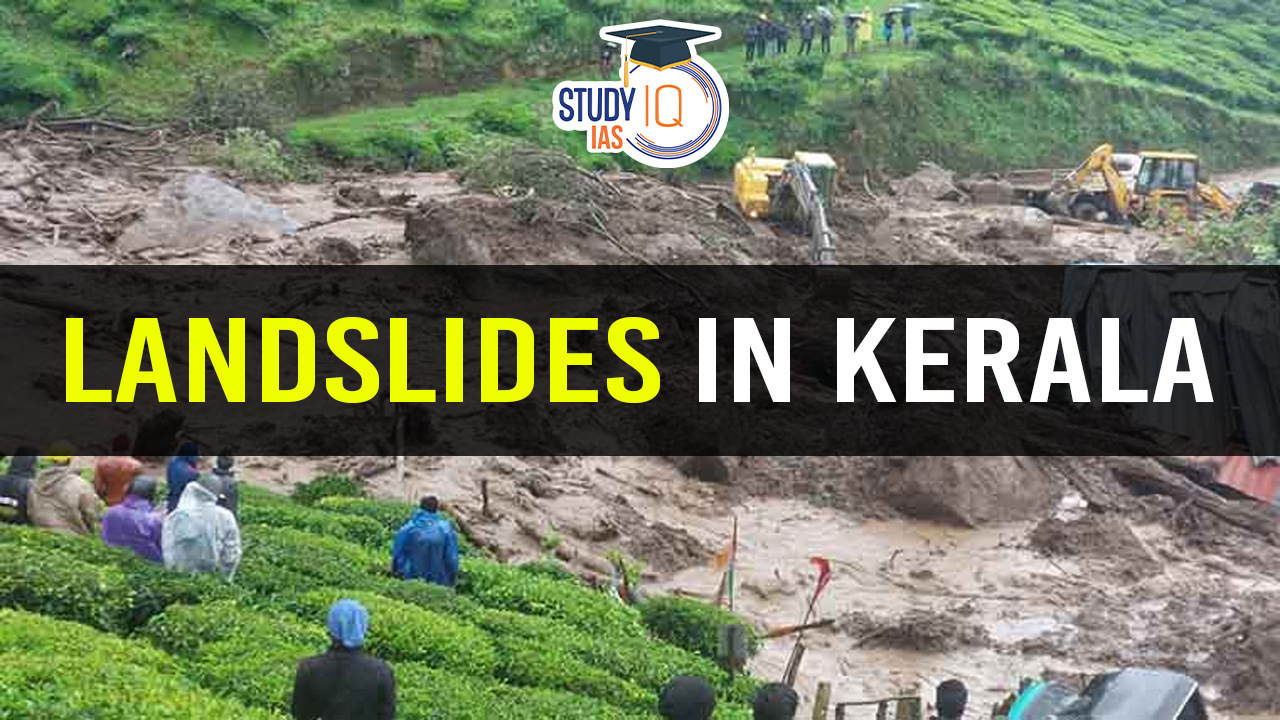Table of Contents
Context: Recently Wayanad district in Kerala experienced multiple landslides, triggered by extremely heavy rainfall.
Background of Landslides in Wayanad, Kerala
- On August 9, 2018, a significant flooding event affected Palakkad due to heavy rains and the opening of the Malampuzha Dam shutters, leading to widespread damage including the sinking of a family car and damage to home appliances.
- Since the 2018 floods, Keralites have adopted the practice of moving valuables to higher floors during heavy rains, reflecting a state of constant vigilance and anxiety during the monsoon season.
- From 2015 to 2022, Kerala experienced the highest number of landslides in India, with 2,239 out of 3,782 national incidents reported from the state. The severe landslides since 2018 in districts like Kozhikode, Palakkad, Wayanad, and Malappuram have collectively resulted in 160 fatalities.
- The magnitude of destruction in 2024 was highlighted by the complete washing away of two villages in Wayanad – Madikkai and Chooralmala, each home to around 1,000 residents, significantly disrupting local life and impeding rescue efforts.
What are the contributing factors for Landslides?
Landslides can be understood by dividing the causes into two main categories: conditioning factors and triggering factors. Here’s a detailed breakdown of each:
Conditioning Factors
These are the underlying factors that make a slope vulnerable to landslides. They generally involve the inherent properties of the slope and its materials:
- Soil and Rock Composition: The type of materials that make up a hill slope, such as loose soil, decomposed rock, or poorly consolidated materials, can influence how stable a slope is.
- Topography: The shape and steepness of the landscape are critical. Steeper slopes are generally more susceptible to landslides than gentler slopes.
- Geomorphology: This refers to the historical and ongoing geological processes that shape the landscape, which can contribute to how prone an area is to sliding.
- Slope Alteration: Natural or human-induced changes in the slope can affect its stability. This includes erosion or the addition of weight on slopes.
- Water Content in Soil: The amount of water present in soil significantly affects its weight and the internal pressure among soil particles, impacting slope stability.
- Vegetation: The type and distribution of vegetation can stabilise a slope through root systems that bind the soil, or conversely, deforestation can increase landslide risks by removing these stabilising agents.
Triggering Factors
These are the immediate causes that initiate a landslide. Often, these factors are events that add sudden stress or change to a vulnerable slope:
- Intense Rainfall: Heavy rain can lead to the saturation of soil, increasing its weight and reducing its internal cohesion, thus triggering landslides.
- Earthquakes: Seismic activity can dislodge rocks and soils, upsetting the equilibrium of a slope and causing it to collapse.
- Volcanic Activity: Eruptions can lead to the rapid deposition of loose ash and debris on slopes, which may trigger landslides under their own weight or when saturated with water.
- Human Activities: Construction, mining, road building, and other land alterations can destabilise slopes by changing load distribution, cutting into the hillside, or altering water drainage patterns.
- Rapid Snowmelt or Glacial Melting: Similar to heavy rainfall, rapid melting increases water content in the soil, potentially leading to slope failure.
| Recent Instances |
Raigad Landslide (Maharashtra):
Himachal Pradesh Landslides:
North India Floods (2023):
Kerala Landslides, 2024:
|
Challenges Associated
- Loss of Life: Landslides can be deadly, especially in densely populated areas. The sudden nature of landslides often leaves little time for evacuation, leading to fatalities and injuries.
- Property Damage: The force of a landslide can destroy buildings, roads, and bridges, causing extensive property damage. This can lead to significant financial losses and long-term economic challenges for the affected regions.
- Infrastructure Disruption: Landslides often block roads and damage critical infrastructure like power lines, water pipes, and communication networks, disrupting daily life and hindering emergency response efforts.
- Environmental Impact: Landslides can cause significant environmental degradation, including the destruction of natural habitats and changes in landscape. They can also lead to the pollution of water bodies due to the influx of debris and soil.
- Economic Burden: The economic impact of landslides includes not only the immediate costs of damage repair and relief efforts but also long-term losses due to the disruption of local economies, especially in areas reliant on agriculture and tourism.
- Rescue and Recovery Challenges: The unstable conditions after a landslide make rescue operations difficult and dangerous. Additionally, recovery and rebuilding efforts can be lengthy and complex, requiring substantial financial and logistical resources.
- Community Displacement: Large landslides can displace entire communities, leading to long-term displacement and the need for significant resources to support relocated populations.
- Early Warning and Monitoring: Developing effective early warning systems and monitoring mechanisms for landslides is challenging, particularly in remote and rural areas. This is crucial for minimising the impact but requires significant investment in technology and infrastructure.
Reports and Recommendations
- Gadgil Committee (2011): Recommended stringent regulations on development in the Western Ghats to prevent ecological damage. Suggested that the entire area of the Western Ghats, including regions like Wayanad, be declared ecologically sensitive, imposing restrictions on activities such as mining and construction.
- K Kasturirangan Report (2013): Proposed a compromise by designating 37% of the Western Ghats as Ecologically Sensitive Areas (ESAs) and banning harmful activities in these regions. The areas under threat, like Wayanad, were recommended for heightened protection and restrictions.
Way Forward
- Enhanced Monitoring and Prediction: Implement advanced technologies such as satellite imagery, remote sensing, and ground-based radar to monitor soil movement and predict potential landslides before they occur.
- Example: In Japan, the use of radar technology and satellite-based systems allows for real-time monitoring of slopes that might be prone to landslides.
- Community Education and Preparedness: Develop and deploy educational programs to teach communities about landslide risks, signs of potential landslides, and appropriate response measures to enhance preparedness and reduce vulnerability.
- Example: In Nepal, community-based programs have been developed where locals are trained to recognize the early signs of landslides, such as cracks in the ground or unusual water seepage.
- Infrastructure Resilience: Design and construct infrastructure with enhanced resilience to withstand landslides, including the use of retaining walls, proper drainage systems, and landslide barriers.
- Example: In Switzerland, barriers and retaining walls are strategically placed in vulnerable areas to prevent landslides from reaching populated areas or critical infrastructure.
- Land Use Regulations: Enforce strict land-use planning and zoning laws that restrict construction in high-risk areas and promote the preservation of natural vegetation that stabilises the soil.
- Example: In the United States, particularly in areas like California, zoning laws restrict construction on known landslide-prone areas.
- Policy Integration and Cooperation: Foster collaboration between governmental agencies, local authorities, scientists, and communities to develop integrated approaches and policies for landslide risk management and response strategies.


 Diwali 2025 Calendar: Dhanteras to Bhai ...
Diwali 2025 Calendar: Dhanteras to Bhai ...
 Significance and History of Diwali Festi...
Significance and History of Diwali Festi...
 The New Power of Rare Earths: How China ...
The New Power of Rare Earths: How China ...




















